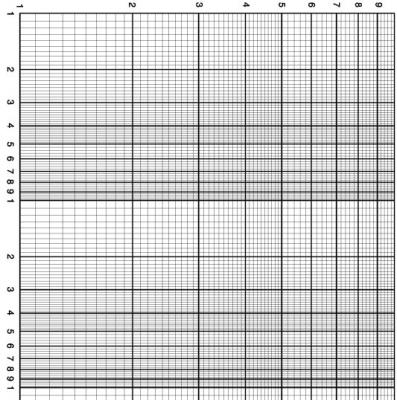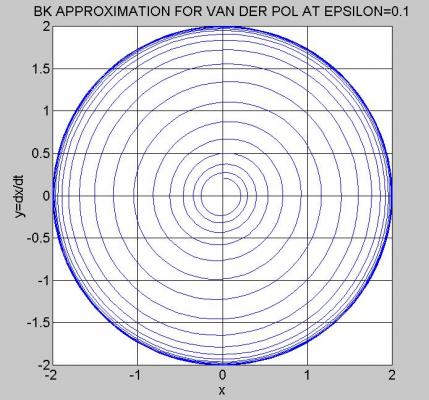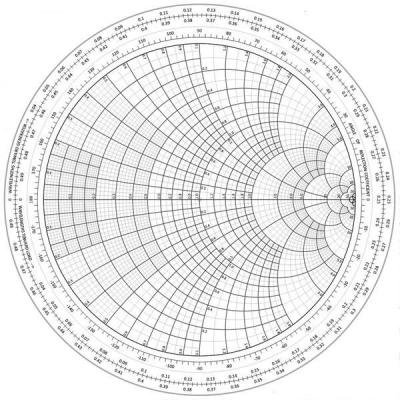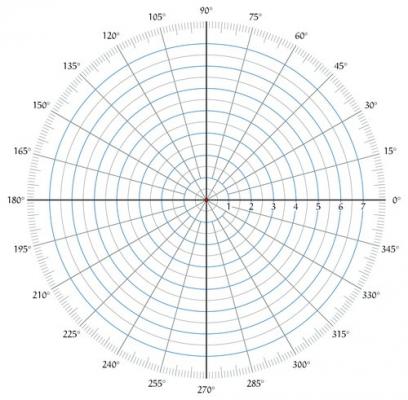-
Posts
17639 -
Joined
-
Last visited
-
Days Won
93
Content Type
Profiles
Forums
Events
Everything posted by studiot
-
The idea is not magic, it is similar to something you may have used in secondary school. Graph paper where the scale is not linear logarithmic graph paper. Here is a simple log-log graph paper. Note that the grid lines becomes closer and closer together as we move away from the origin. So that because of the nature of the logarithm we can compress infinity into this space. Of course with Poincare we are talking about polar coordinates. Here are a linear, uncompressed version. Note the grilines are evenly spaced. and here is a compressed version along the same lines Note the grid lines get closer as we approach the edge of the disk. We can also offset the origin as in the Smith chart
-

no such thing as "infinity" in the real world (split)
studiot replied to cladking's topic in Speculations
"Pour encourager les autres" -
Excellent riposte. +1 I like to end a talk with this slide, and then declare the bar open, though for some audiences I might substitute a cup of tea. On a more serious note, photoelasticity of cracks produces some wonderful images, and some great mathematical physics. https://www.google.co.uk/search?q=photoelasticity&hl=en-GB&gbv=2&prmd=ivns&source=lnms&tbm=isch&sa=X&ved=0ahUKEwiDtLCa55zMAhVpJMAKHUe4DHcQ_AUIBQ Another hugely important mathematical aspect of cracks in materials is called dislocation theory. https://www.google.co.uk/search?q=dislocation+theory&hl=en-GB&gbv=2&prmd=ivns&source=lnms&tbm=isch&sa=X&ved=0ahUKEwjeuP_C8pzMAhXkDsAKHYoyC6wQ_AUIBQ Cracks are serious business.
-
This can be a fascinating subject that is about far more than fractals, and can draw in many important parts of Physics and Maths, Chemistry, and Biology. There is also a very good book about this, that is not highly mathematical; The Self-Made Tapestry Pattern formation in nature By Philip Ball I once gave a lecture to the Concrete Society about cracks in concrete, and compared them with cracks in wood and elsewhere, with lots of powerpoint pictures.
-

no such thing as "infinity" in the real world (split)
studiot replied to cladking's topic in Speculations
Good thinking +1 I take it you are now willing to acknowledge that the abtract can have real existence as Delta1212 says , So we are definitely agreed that the abstract mathematical concept of infinity has real existence for us to work on. As a matter of interest here is another (mathematical) definition of infinity, (due to Cantor) Consider the counting numbers 1,2,3,4....... For each one I can write the square of the number underneath 1,2,3, 4..... 1,4,9,16.... Now look again carefully. Every square is also a counting number, but the list of squares does not include all the counting numbers. So the set of all the squares is only a part of the set of all the counting numbers. But I have put these sets in one-to-one correspondence so they must have the same number of members. This is the basis of Cantor's definition of infinite as something that can be put into one-to-one corresponcence with a part of itself. It is a very powerful concept that finds application in formal logic and mathematics and pleasing because it does not require the concept of 'anything carrying on forever and never finishing' -

I found this poster in the hallway today and it made me laugh
studiot replied to Arete's topic in The Lounge
Nice one Cyril, Nice one Sam +1 -
Perhaps when you do you will pick out a short list of key points you would like answered. Meanwhile I recommend looking at The Emerald Planet by David Beerling It is the only book dedicated to a geological history of the Earth's atmosphere (and to a lesser extent the hydrosphere) that I know of. You might find some suprises there.
-
An object with zero velocity has zero momentum, but it still has inertia. Inertia is a measure of mass which is the factor in momentum that is classically independent of velocity.
-
Thanks, Bill Angel and prometheus, I didn't know that about J. Carter and Merkel. +1 John Cuthber, yes M. Thatcher was a graduate chemist and whilst she may have done much to offend, she was in the forefront of restoring the ozone layer by controlling CFCs. I put that down to the science element of her background, rather than the grocery element.
-
I have to say that I'm getting suspicious of the OP motives here. screwstrip I'm not sure how this is a problem. Any ToE is going to have broken symmetries, resulting in interacting components. For example electroweak symmetry -- at low energies the symmetry is broken resulting in EM and the weak force. Is the universe more 'boring' because we know they unify at some level? Each answer to the only poster offering potential support is an oblique brush off. So if you grab your ankle with your hand, you are still playing with yourself. Yes that is boring to me.
-

Waveform of an electron
studiot replied to petrushka.googol's topic in Modern and Theoretical Physics
OK, let us examine this claim that the electron is the orbital and the orbital is the electron under any circumstances. I have a pendulum clock. The pendulum swings to and fro marking out a sector of a circle. This sector does not have a particular name (that I am aware of) but I will call it the swingspace. I hope you will not claim that the swingspace is the same as the pendulum itself, but it has the same, or very similar, characteristics as an orbital. The properties involved in the equation of motion of the pendulum reduce to zero outside the swingspace and defined everywhere within it. The pendulum can considered as a point mass in a potential field, for the purpose of obtaining solutions to this equation. The boundary conditions are set by the potential field not the mass of the pendulum. The equation of motion of the electron in a potential field is set by the boundary conditions, not the electron charge or mass. In this equation the electron is considered a point mass and a point charge. Solution of this equation yields a more complicated property than the pendulum solution that has a value of all space (ie every point in space). Most of this value is concetrated into a particular region of space we call an orbital. The usual graphic that we draw as s, p, d etc orbitals corresponds to a surface in 3D space that contains 90% of the probability density of this solution, given by the square of the wave function that is the solution to the electron's equation of motion. So the orbital corresponds to the swingspace of my pendulum. -
I don't know if FW's hypothesis is the same or not, but I thought you might be interested in comparable ideas. The main thing about FW's 'medium' is that it is not incompatible with modern measurements. He does discuss similarities and differences with aether theories. Personally I find the qeust for grand unified theories boring. If it it ends up showing there is only one agent at work in the whole universe then there is only one thing left for that agent to interact with - itself. I much prefer the universe of a multiplicity of agents and a myriad of interactions.
-
screwstrip Alright, sorry. If one were to assume that space was filled with a medium and that medium could explain all natural phenomena what would the properties be of that medium and how would it operate? Well this certainly belongs in speculations. However that is not bad and indeed, properly handled, it could become an exemplary speculations thread. Sounds to me like to are describing Frank Wilczek's hypothesis. Have you heard of him, he was the 2004 Nobel winner in Physics? I recommend his book, The Lightness of Being to you for comparison
-
You are more likely to engage responders here if you read and conformed to the rules for posting here. Can you rephrase your question so that I don't have to go off pitch to find out what it is please?
-
If you really want witchcraft and alchemy, how about this: There is a non zero, although vanishingly small, probability that the tea will quantum tunnel through the cup wall and keep going. However I would point out that every time I go scuba diving I bet my life on the quantum probability that the air in my tank will not quantum tunnel out of my air tank. I also rely on my dive computer, which uses quantum tunneling to operate in the sub atomic realm, not to run out of air in the conventional manner.
-
If you stop the cup moving forwards how can the tea continue moving, except upwards? The tea is tightly packed into the cup. Would a tightly packed solid do the same?
-

What is the Quantum Theory? Enlighten Me!!!
studiot replied to bluescience's topic in Quantum Theory
Nice overview +1 -
Thank you for this information since the proposed new EDF plant will be in my backyard if built. Edit There is more to be said in general. The incident was apparently in 2014, but more data is coming to light now. http://www.dw.com/en/reports-fessenheim-nuclear-accident-played-down-by-authorities/a-19093477
-
Quite likely, since at least one purpose of using LED lighting is to use less electricity. Power that is not drawn from the mains does not go anywhere, any more than power that is not drawn from an unused socket (wall outlet) goes anywhere. Engineering is quite contrary to politics where they pay farmers to not grow turnips under a scheme called setaside. Be glad of this because think how much your electricity company could charge if it could charge for power not drawn. That is done to some extent where the capacitive power factor of street lights is offset against the inductive pf of consumers. However if your installation has a power factor of say 0.8, then as I already described, the power company's supply has to have a large capacity to supply you with say 25 kilowatts than it would if your power factor was 1.0, like say your neighbour enjoys. Say you and a friend went to the ice cream van and each bought an ice cream, but you bought a double and he bought a single cone. Would your friend be happy if the vendor said I'll average it and charge you both for 1.5 cones?
-
You do not need electromagnetism, witchcraft or alchemy to explain this. Tea, in a cup, is a liquid and liquids possess a property not available to any appreciable extent to solids. A liquid converts a force exerted on it by its container into internal pressure within the liquid. Take a tube of toothpaste or ketchup, point it upwards and squeeze it. The force of your fingers is converted to increase pressure within the tube and this causes the liquid paste or ketchup to rise vertically. In your teacup, when you stop the front side of the cup exerts a horizontal force on the liquid nearest to it. This increase the pressure in that part of the tea. The increased pressure causes the tea to rise in that part of the cup and slop over the edge. You can create more complicated explanations involving momentum, but the explanation is still mechanical in nature.
-
We discussed light sources in general and LEDs in particular a few years back, and I reported results of my trials of some LED lights. Here is more gneral information http://www.scienceforums.net/topic/67711-led-and-other-light-sources/ Here is a long thread pages3 and 4 are the most relevant. http://www.scienceforums.net/topic/67073-cfls-not-a-bright-idea/page-3
-
I know it is difficult to use popular language and be precise at the same time, It is all too easy to say or imply something untrue,so you have to be very careful to avoid this. All harmonics are sinusoidal waves. Power factor is just as important with a single frequency pure sine wave as with a distorted one. It is not the distortion that lowers the power factor, it is the reactive components in the load. With a purely resistive load the power factor would remain at 1, whatever the waveshape.
-
So often Wiki get too esoteric about a subject and does not offer a simple introduction/explanantion. So here is my rough guide to power factor. I would suggest that looking at power factor correction would suit you better. https://www.google.co.uk/search?hl=en-GB&source=hp&biw=&bih=&q=power+factor+correction&gbv=2&oq=power+factor&gs_l=heirloom-hp.1.1.0i131l2j0l8.1141.3516.0.10344.12.8.0.4.4.0.125.969.0j8.8.0....0...1ac.1.34.heirloom-hp..0.12.1127.fuIIDDE7fDM Things to note. In DC electricity power equals the voltage x the current in all cases. In AC electricity there may be a mismatch of timing between the current and voltage which means that the power you can extract from the supply is less than the product of voltage and current. Thus in order to obtain a specific power, eg 1 kilowatt, you have to live with a higher value of voltage x current. Since the mains voltage is fixed this means a higher current. Thus the cabling has to be sized for this larger current. The greater the mismatch the greater the cable size. This is the reason for the extra copper. Power factor is a measure of this mismatch. The ideal value is 1. Power factor depends on the device connected, not on the supply. There are two types of power factor, positive and negative. This arises because there are two additional types of device in AC electricity over DC. These are called capacitive and inductive devices and create power factors of opposite sign. The main capacitive types are flourescent and more modern lights. the main inductive types are electric motors. Industrially their two power factors can be used to cancel each other out, makeing the overall power factor closer to 1. This is known as power factor improvement and many suppliers charge a premium the further your power factor is from 1. I would say the two greatest faults with LED lighting installations ar. 1) They still generate much heat and insufficient provosion for dissipating this has lead to fires. 2) They have a very different light distrbution pattern, particularly compared to flourescent. They are a very concentrated, intense source. as such they are unsuitable for recessed fittings, often favoured for flourescents. Many LED installations retro-fitted to recessed ceilings have proved a great disappointment as much of the light never leaves the recess and the lighting appears dim.
-
The terms are too general to offer meaning to, but please let us know if you find out anything useful.
-

Does math solve everything?!
studiot replied to IAstroViz's topic in Linear Algebra and Group Theory
If that was my thermometer it would actually tell me it has been stuck since last summer (??) !






